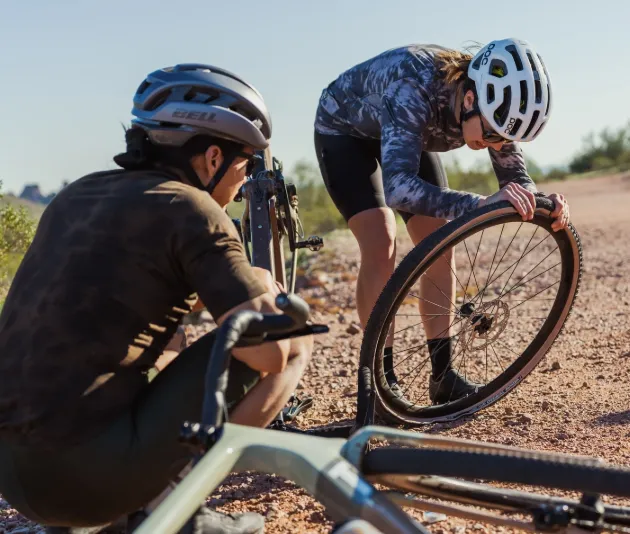As the weather warms up, it’s time to get your bike ready for outdoor adventures. Whether you’re heading out for a leisurely ride or tackling a more challenging route, performing a quick bike check before hitting the road is crucial for ensuring a safe and smooth ride. Here’s a simple guide to help you conduct the essential checks on your bike.
1. Check Your Tires
The first step in your bike check is to ensure your tires are properly inflated. You can find the recommended tire pressure range printed on the side of each tire. Use a tire pressure gauge to make sure the pressure is within this range, and adjust accordingly using a pump.
Lower Pressure = A more comfortable ride, less speed.
Higher Pressure = Less bounce, harder ride, more speed.
Additionally, inspect your tires for any visible damage such as cuts, punctures, or bulges. Clear any debris like glass or stones that might be embedded in the tire. If the tires are worn out or old, it’s time to replace them.
2. Brake Check
Brakes are a crucial safety feature, so it’s important to check their functionality. Lift the bike and spin each wheel. Squeeze the brake lever and ensure the wheel slows gradually without resistance or odd noises. If the brakes feel off, you might need to make adjustments.
Check the brake levers, cables, and housings for any damage or wear. Frayed cables can be dangerous, so replace them if needed. Make sure the wheels are properly aligned and that the quick-release skewers or bolts are tightly fastened.
3. Headset and Handlebars
Your bike’s headset, stem, and handlebars need to be secure for safe riding. To check, pull on the front brake and rock the bike back and forth. Any movement in the headset means it needs tightening. Adjust the headset bolt carefully, making sure not to over-tighten it.
Once that’s done, lift the front of the bike and test if the handlebars turn smoothly in both directions. If you feel any wobble, tighten the bolts on the stem. Ensuring the handlebars are stable and responsive is key to a safe ride.
4. Inspect the Frame and Forks
It’s always good practice to check your bike’s frame for cracks or signs of wear, especially if you’ve recently encountered rough terrain. Pay attention to areas like the head tube and bottom bracket, where cracks are most likely to occur. Also, lift the back wheel off the ground and rotate the pedals. If you hear creaking or ticking sounds, the bottom bracket might need attention.
Make sure your pedals spin freely on their axles. If they don’t, they might need to be adjusted or replaced.
5. Saddle and Seat Post
Check the saddle’s stability by twisting it gently. If there’s any movement, tighten the seat post bolts or quick-release mechanism. Ensure the saddle is level and stable, and adjust it to a comfortable height before your ride. A secure saddle is essential for comfort and control.
6. Gear Shifting and Adjustment
To test your gears, lift the rear wheel and rotate the pedals. If the chain doesn’t shift smoothly, adjust the gear cables. If it’s hard to shift to a smaller gear, loosen the cable slightly using the barrel adjuster on the rear derailleur. For a shift to a larger gear, tighten the cable by turning the adjuster clockwise.
If you’re still having issues, or the gear adjustments don’t improve the shifting, it’s a good idea to have a professional mechanic take a look.
7. Clean and Lubricate the Chain
A well-maintained chain is vital for smooth pedaling. Clean the chain with degreaser and a stiff brush, followed by a rinse with water. Once clean, apply lubricant to the chain. Turn the pedals backward while applying the lube to ensure the oil reaches every link.
Wipe off any excess lubricant to avoid it splashing onto your bike’s wheels or brakes during your ride.
8. Final Safety Check
Before heading out, double-check the condition of your bike. Make sure everything is securely fastened, from the handlebars to the seat post. Ensure your bike is in top shape by inspecting each component, including brakes, tires, and gears. Regular checks can prevent issues and keep your rides safe and enjoyable.
By following these simple steps, you’ll ensure that your bike is ready for any adventure ahead. Happy cycling!












